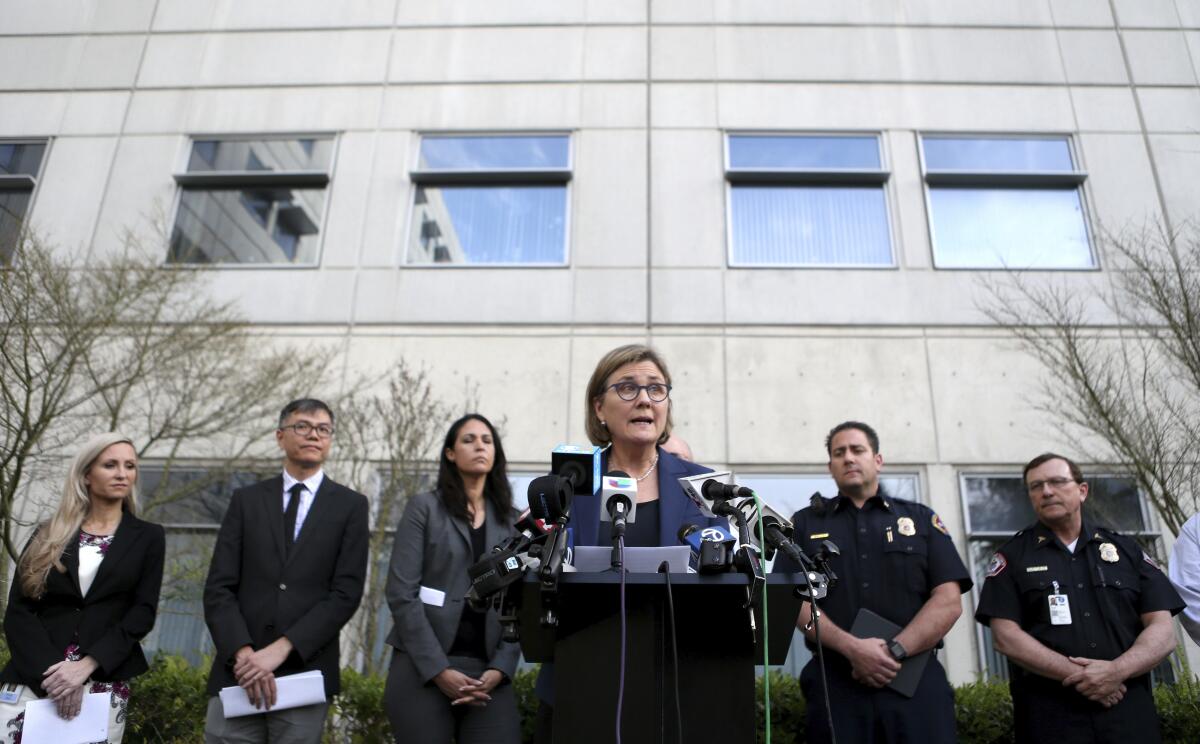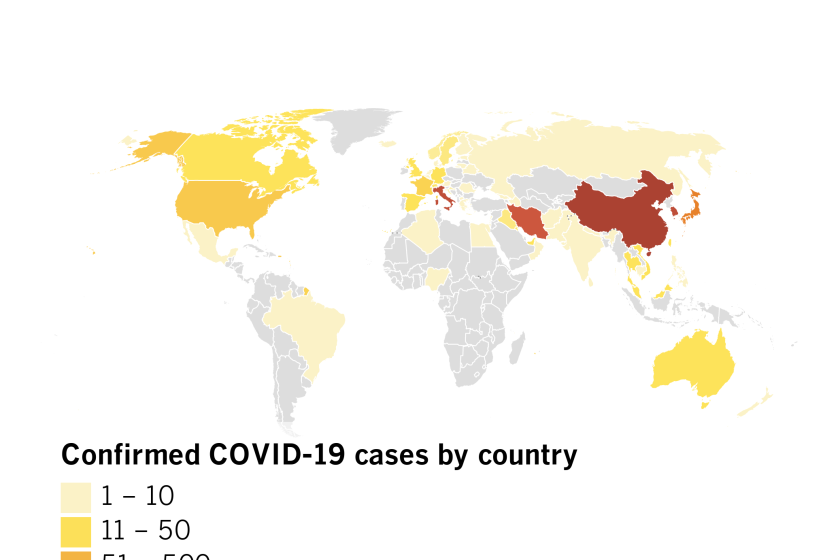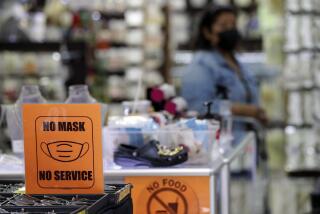Coronavirus deaths in U.S. increase; official warns of many more cases

- Share via
KIRKLAND, Wash. — As three more deaths in the United States were linked to the coronavirus Tuesday, World Health Organization officials warned the virus could be far more dangerous than the flu, with a mortality rate of 3.4%.
During an off-camera news conference at the White House with the task force charged with overseeing the federal government’s response, Robert Redfield, director of the Centers for Disease Control and Prevention, delivered a message to the American public:
“I want them to be prepared for the reality that ... there are going to be more cases in the community,” he said. “But I want them to continue their daily lives. I want them to be mindful of the opportunity again to prepare themselves and their families.”
Redfield said scientists did not have the data to predict the future spread.
“What we do know for sure is that in the right setting, it does have the potential to move quickly,” Redfield said. “When you think that just a couple of weeks ago there were less than three cases in Korea, now there’s 2,500.”
Public health officials confirmed a nursing home patient in Washington state was admitted to Harborview Medical Center in Seattle on Feb. 24 and died two days later. The patient, a 54-year-old man who had underlying medical conditions, was transported from Life Care Center of Kirkland and died days before several other patients at the nursing home were linked to the coronavirus, hospital spokeswoman Susan Gregg said.
The Seattle and King County Public Health Department on Tuesday reported two additional deaths from COVID-19, bringing the King County total to eight. The other person who died was from Snohomish County, health officials said.
A North Carolina resident who visited the Kirkland facility has since tested positive for the virus, becoming that state’s first case of COVID-19, Gov. Roy Cooper announced Tuesday. Health department officials in North Carolina are working to identify anyone else who may have come in contact with the individual.
“I know that people are worried about this virus and I want to assure North Carolinians our state is prepared,” Cooper said in a statement, noting that the person represents an isolated case.
New York City confirmed its first case of “community spread” coronavirus — the second case of the virus in the state. The individual is a man in his 50s who lives in Westchester County but works at a law firm in Manhattan. The man is hospitalized and in severe condition.
The global mortality rate — which includes more than 3,000 deaths — is many times higher than the mortality rate of the flu, which is less than 1%. WHO Director-General Tedros Adhanom Ghebreyesus said that is at least partly because COVID-19 is a new disease, and no one has built up an immunity to it.
Still, Tedros reiterated the WHO’s belief that containment was still within reach.
“We don’t even talk about containment for seasonal flu,” Tedros said. “It’s just not possible, but it’s possible for COVID-19.”
Officials say they have learned the coronavirus is less transmissible than the flu, which is often spread by people who are infected yet don’t have symptoms. That doesn’t seem to be the case for COVID-19, he said.
“There are not yet any vaccines or therapeutics, which is why we must do everything we can to contain it.”
Mike Ryan, who runs the agency’s emergencies program, pushed back against officials who wanted to “wave the white flag” and surrender to the disease’s hold. China took drastic steps to fight the virus, he said, and case numbers are now on the decline there.
Countries such as China and South Korea “implemented very, very strong measures that have affected their own economies and their own societies,” Ryan said. “It’s really a duty of others to use the time that has been bought.
“That is not a reverse you can achieve with influenza. If that is a failure, we’ll have slowed down the virus.”
The vast majority of confirmed coronavirus cases — nearly 94% — have occurred in mainland China. But illnesses have been confirmed on all six continents.
There can be a big benefit in slowing the virus’ arrival in a country for a few months, Ryan said. Many countries, including the U.S, are in the middle of flu season, so large numbers of coronavirus cases would overwhelm the health system.
In Italy, COVID-19 patients and flu patients are already stretching hospitals and healthcare facilities, he said.
Tedros said he’s concerned by shortages of masks, gowns and other equipment needed by healthcare workers to stop the spread of disease “caused by rising demands and hoarding and misuse.”
“We can’t stop COVID-19 without protecting our health workers,” said Tedros, noting that prices of surgical masks have increased sixfold.
Current information suggests that most COVID-19 cases are mild, said Dr. Nancy Messonnier, the Centers for Disease Control and Prevention’s director of the National Center for Immunization and Respiratory Diseases. According to a report out of China, the most serious illnesses occur in 16% of cases, she said, and older people and those with underlying health conditions are twice as likely to develop serious outcomes.
Speaking during a media briefing Tuesday, Messonnier said that cases similar to those reported abroad were now appearing in the United States.
The CDC is relying on local health clinicians to determine testing needs. In addition to CDC test kits, commercial manufacturers overseen by the Food and Drug Administration are providing tests directly to states. These types of tests are typically what are on the front lines in the United States, Messonnier said.
Vice President Mike Pence said Tuesday that 77 cases of coronavirus have been diagnosed in the U.S. That number excludes the 45 people who were passengers aboard the Diamond Princess cruise ship in Japan and were repatriated to America, which brings the total to more than 120.
Pence said that a task force will issue new guidance from the CDC to make it clear that any American can be tested for the virus and no restrictions subject to doctor’s orders.
Commercial laboratories are expected to have 2,500 test kits available to provide 1.5 million tests. And the Office of Management and Budget will direct all federal government agencies to review internal travel and adhere to State Department guidance.
“The threat of the coronavirus to the American pubic remains low,” Pence said.
Pence also said that chief executives of all major airlines are expected to meet at the White House Wednesday to discuss contact tracing data for the coronavirus.
The West Coast continues to bear the brunt of the illnesses in the U.S., with the focus on Northern California and Washington.
At least five Northern California counties reported new cases of COVID-19 on Monday. On Tuesday, the city of Berkeley reported its first case after an individual visited a country with an outbreak. That individual has remained at home in a self-imposed quarantine since returning.
“While the risk of infection remains low, the expanded presence of the virus in our community is a reality we should all prepare for,” said Berkeley Health Officer Dr. Lisa Hernandez. “There are steps that all of us in the community can take now to improve basic hygiene and also prepare for a wider spread in the future.”
Gov. Gavin Newsom announced Tuesday that the California Department of Public Health received approval from the CDC and the National Institute of Occupational Safety and Health to dip into its emergency planning reserves of 21 million N-95 face masks for medical workers on the front lines.
Though the flurry of positive test results in recent days does signal that the virus is circulating within the U.S., experts advised the public to avoid reading too much into those numbers.
Until late last week, federal officials were not allowing widespread testing for the virus, so many people who were already sick are only now being diagnosed, said Harvard epidemiology professor Marc Lipsitch.
“Some of the numbers are changing because new things are happening, but a lot of the numbers are changing because we’re discovering things that have already happened,” Lipsitch said in a forum Monday hosted by Harvard’s public health school. “It’s really important to distinguish ‘Oh, goodness, there’s a new cluster’ from ‘Oh, goodness, we just discovered that there’s a cluster that’s been there for some time.’ ”
As the virus spreads, officials are trying to push back against Asian American bias and misinformation surrounding the outbreak.
Amid signs that some are staying away from Chinatowns and other Asian communities in the U.S., Sen. Dianne Feinstein (D-Calif.) sharply criticized the xenophobia that had been displayed toward ethnic communities.
“We’ve also seen a rise in racism toward Asian Americans because the virus is associated with China,” she said. “This is unconscionable, and it’s not the American way. People of all ages, races and ethnicities are susceptible to this disease. Bigotry toward any one group for a virus they have nothing to do with makes no sense.”
Several areas in California have declared local emergencies amid the outbreak. Sonoma County on Monday issued a declaration after announcing two people had been diagnosed with the virus. One infected person returned from a cruise to Mexico 10 days ago and was hospitalized, but the case “is a cause for concern,” said county health officer Dr. Celeste Philip.
Declaring a state of emergency will allow the county to respond properly to the outbreak as well as “work in tandem with our cities and healthcare providers to ensure we are prepared to combat an outbreak of COVID-19 in our communities,” Philip said in a statement.
Meanwhile, more COVID-19 cases were reported in Santa Clara County, bringing its total to 11 — the most of any California county. The source of infection for the latest two cases, reported Tuesday, is still under investigation.
Many initial reports of COVID-19 have been among healthcare workers, who are likely to encounter sick patients. Hundreds of healthcare workers in California have already been asked to stay home due to contact with patients diagnosed with the disease over the last few weeks.
On Monday, Placer County reported a confirmed case of COVID-19 in a healthcare worker at NorthBay VacaValley Hospital in Vacaville, where a COVID-19 patient had been admitted. County spokeswoman Katie Combs Prichard said the medical worker, who lives in Placer County, came into contact with that patient and was likely infected by her.
Conferences in the state and elsewhere are being canceled or scaled back amid fears of the virus, but the WHO’s Ryan said decisions to cancel mass gatherings, including sporting events, should be determined by a country’s leadership, based on how severe the outbreak is in their region.
Officials recently had a call with the International Olympic Committee to discuss the Summer Olympics scheduled in Tokyo and decided to continue monitoring the situation, with three months given before a decision must be made.
“I have confidence in Japan that there will hopefully be progress,” Tedros said. “Deciding now could be too early.”
President Trump said Tuesday during a speech to the National Assn. of Counties’ legislative conference in Washington that he expected Congress would pass a special funding bill providing $8.5 billion — far more than he requested — to fight the spread of the illness in the United States.
“It just shows you what can happen — six weeks ago, eight weeks ago, you never heard of this. All of a sudden, it’s got the world aflutter,” Trump said, noting later while leaving the White House to visit the National Institutes of Health that he is looking at further international travel restrictions involving Italy, Japan and South Korea, but will not limit domestic travel.
Anthony Fauci, director of the National Institute of Allergy and Infectious Diseases, said there remained many unknowns about the virus, including the degree to which people who do not express symptoms can transmit it to others. He said doctors know that it happens but have not yet gauged the extent, a key piece of data that will help determine decisions on how to contain it.
Fauci said that Chinese data are believed to be accurate and that the spread of the virus there is slowing thanks to “draconian” methods that would never occur in the United States, including stringent travel and public gathering restrictions.
“They have taken social distancing to its furthest extreme,” he said.
Bierman reported from Washington, D.C., Read from Kirkland, Wash., and Shalby and Karlamangla from Los Angeles.
More to Read
Sign up for Essential California
The most important California stories and recommendations in your inbox every morning.
You may occasionally receive promotional content from the Los Angeles Times.















